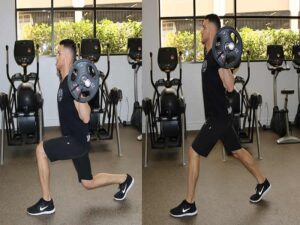One of the best exercises for the lower body is barbell stationary lunges. They can be anywhere, even while taking a walk with buddies. You will get firmer buttocks, feet, and balance. The legs, quads, and pelvis are of the lower muscular systems and during the barbell stationary lunge. Understand how to perform barbell lunges correctly.
Did you Know Barbell Stationary Lunges?
The lateral lunge is a physical workout and is you until your frontal and rear legs are at 90 degrees. Barbell lunges are a high reward workout of this movement. Rolling, reverse, lateral lunges, dividing splits, weight training, and other lower-body are all to barbell thrusts. Kettlebell lunges and free-weight lunges both have advantages. It is if you want to incorporate loaded lunges into your at-home but don’t have a barbell.
Ways to Barbell Stationary Lunges
They are the following:
- The way you were in a back squatting position with the barbell on your spine.
- As you advance with one foot, take a tall stance, inhale deeply, and tighten your abdominal muscles. Proceed that allows for the fullest lunge without experiencing pain and encourages proper form. A short step will make the motion more difficult to execute. It requires more coordination and movement. Both the front and the back foot should now be pointing forward, with the back heel lifted.
- To descend, flex both knees, allowing the front knee to move along before stopping over the feet. The rear knee ought to be barely off the floor. Hold the front foot firmly grounded and align your knee. It is with your foot during the lunge to prevent knee or joint strain.
- To finish the round, engage the glutes. It is while kicking the front foot off the ground to get back to stance.
- For the needed reps, perform the movement again on the same side.
Advantages of Barbell Stationary Lunges
Strengthen Your Equilibrium & Coordination
You must stabilize your core body during the stationary lunge. It is because you are leaning on the ball of your rear leg. Your toes are also from front to rear, which calls for a different method of standing. You contract your core and maintain a tall stance to stay steady. It is an excellent core exercise.
Choose Variations
The barbell lunge has several variations, which is an advantage. One method is to perform repetitions alternately by hanging leg raise. It is for the following round and lunging forward with the other. Place one shoe on the ground and perform multiple lunges while switching as an alternative. Strengthen your back cord and ease the strain on your toes. You can even lunge downward.
Reduces Muscle Imbalance
When performing a bilateral workout, both sides are simultaneous. It frequently allows the dominant side to take control and widen the strength difference between the halves. Concentrating on one side with unilateral workouts can lessen muscle instability. The lunge is excellent for resolving lower body asymmetries. It is unilaterally on one side of the body will also improve your capacity. It is to master the same skill on the opposing side of the frame.
Modifications to Barbell Stationary Lunge
Reverse lunges with a barbell
Those who endure knee soreness during the forward lunge will benefit from it. It is executed similarly to a barbell lunge, but reversed. Backing up a step prevents the frontal knee from moving into a potentially painful area. Similar to the barbell stationary lunge, the barbell reverse lunge can enable joint alignment easier to keep.
Lunges with a barbell vertical
The Upper Barbell Lunge requires a lot of upper-body motion and is a very challenging workout. Because the torso cannot lean forward as with other lunges, this workout is more quadriceps-dominant. The lunges are while holding the bar overhead. In the cases, persons lack the motion range necessary to raise their arms aloft. It is in a fixed, secure place. If upper body mobility is restricted, postural choices like folding the elbows or arching the spine will occur. The overhead thrust will train the body in unstable situations. It aids in a solid overhead position if movement is not a problem.
The alternating-barbell lunges
You will switch between using both legs during this Barbell Lunge. It is a variant rather than performing the complete set on one leg. It will prolong the burn by the lactic acid being flushed out of the leg as they alternate. The variant works well if the focus is on muscle mass rather than muscle gain. You could utilize big weights and a slightly smaller repeat range for it.
Working Muscles with Barbell Stationary Lunge
Quadriceps:
The quads muscle is in the front of the calf. The muscle group in the body is of four divisions. You can keep your balance and improve your speed with quads.
Abdominals:
The strongest tendon in your posterior is the gluteus maximus. Functioning glutes give your body more support and provide stability for activities.
The lumbar extensor muscles
At the apex of your thigh, there is a collection of muscles known as the hip flexors. They enable your lower to move in a variety of ways. Exercises for your legs, such as the barbell lunge, serve to develop your leg muscles. You can walk about freely every day.
Hamstrings:
The ligaments at the rear of your leg that connect your calf muscle to your leg bone are your hamstrings. A set supports the knee joint, reduces painful symptoms, and improves posture and agility.
Final Words
The barbell stationary lunges are the best exercise for building strong, slim legs and buttocks. They are a lower body action neglected. Although a barbell also functions well, most athletes choose it with a pair of weights or resistance bands. An intense training program could collaborate your leg muscles. You’ll be stunned by the outcomes if it is on your limb workout. Have a set of dumbbells, perform each activity the specified number of times and then take a break.

